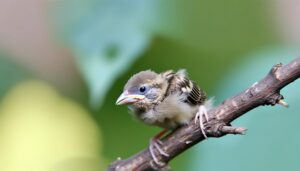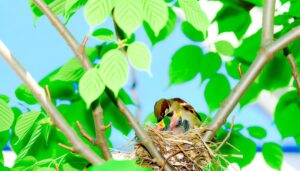Tell If a Baby Sparrow Is Dying: Identifying Signs
To determine if a baby sparrow is dying, watch for lethargy, labored breathing, and refusal to eat. Check for drooping wings, sluggish behavior, and abnormal feather conditions.
Observe any signs of dehydration, such as dry eyes and mouth. Look for visible injuries like bruising or open wounds.
Monitor droppings for unusual colors or consistency. Assess temperature regulation; a sparrow that's cold or overheated is in danger.
Finally, test responses to stimuli; a lack of reaction is concerning. Immediate care and professional help are essential.
For further detailed insights into each symptom, consider exploring more.

Key Takeaways
- The baby sparrow is lethargic and unresponsive, showing little to no movement.
- It exhibits labored breathing with open-mouth or irregular breathing patterns.
- The sparrow refuses to eat, showing signs of severe weakness or illness.
- Dehydration signs like dry, sunken eyes, and hard, small feces are present.
- It has unusual feather conditions such as missing, patchy, or discolored plumage.
Lethargy and Weakness
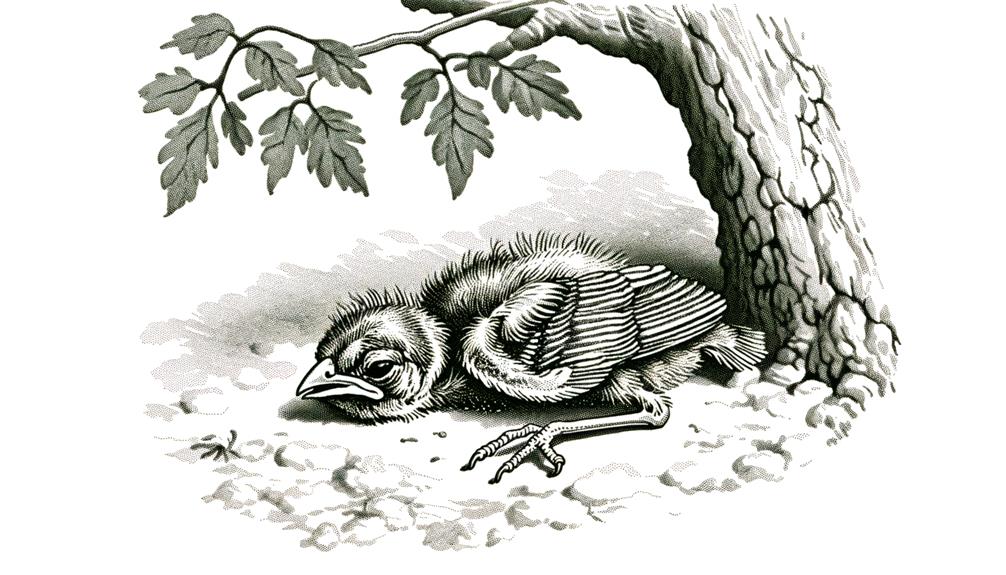
One of the key indicators that a baby sparrow might be dying is noticeable lethargy and weakness. You'll observe that the bird is notably less active than usual, often remaining in one place for extended periods. It may struggle to stand or move, appearing sluggish and unresponsive.
When you gently touch or nudge the sparrow, it won't react with its typical quick movements. Additionally, the baby sparrow's wings may droop, and it might have difficulty holding its head up.
Pay close attention to its feeding habits; a dying sparrow often refuses food or eats very little. Monitoring these signs closely allows you to take swift action, potentially increasing the bird's chances of survival through timely intervention.
Labored Breathing
When you observe rapid chest movements, open-mouth breathing, or irregular breathing patterns in a baby sparrow, it's a sign of labored breathing.
These symptoms indicate respiratory distress, which can be critical.
You should act quickly to address these issues and seek professional help.
Rapid Chest Movements
Rapid chest movements in a baby sparrow often indicate labored breathing and can be a sign of respiratory distress or underlying health issues. You should observe the frequency and intensity of the chest movements.
If the sparrow's chest rapidly rises and falls, it may be struggling to get enough oxygen. This can result from infections, obstructions in the airway, or physical trauma. Monitor the bird's behavior closely; unusual lethargy or weakness often accompanies labored breathing.
Immediate intervention is essential. Consider contacting a wildlife rehabilitator or avian vet for guidance. Rapid chest movements alone don't necessarily diagnose the issue, but they do signify that the baby sparrow needs urgent attention to potentially prevent further decline.
Open-Mouth Breathing
Open-mouth breathing in a baby sparrow signifies severe respiratory distress and indicates that the bird is struggling to breathe properly. You'll notice the sparrow keeping its beak wide open, attempting to intake more air. This often accompanies other signs like rapid chest movements and unusual exhaustion.
Causes can range from respiratory infections, obstructions in the airway, to environmental factors like smoke or poor ventilation. Immediate intervention is vital. Confirm the sparrow is in a well-ventilated, warm area. Avoid handling it excessively to reduce stress.
Contact a wildlife rehabilitator or veterinarian experienced with birds as soon as possible. They can provide oxygen therapy or other medical treatments essential for recovery. Your prompt action can make a significant difference.
Irregular Breathing Patterns
Labored breathing in a baby sparrow often presents as irregular, strained breaths that indicate potential underlying health issues. You might notice the bird gasping or taking shallow, rapid breaths. Watch closely for any wheezing or clicking sounds, as these can signify respiratory infections or obstructions.
To determine if the sparrow's breathing is labored, observe its chest movements; exaggerated or uneven expansions often point to distress. It's essential to act promptly. Provide a warm, quiet environment and minimize handling to reduce stress.
If possible, consult a wildlife rehabilitator or avian veterinarian immediately. Early intervention can make a significant difference in the sparrow's chances of recovery, so your timely and compassionate response is crucial.
Unusual Feather Condition
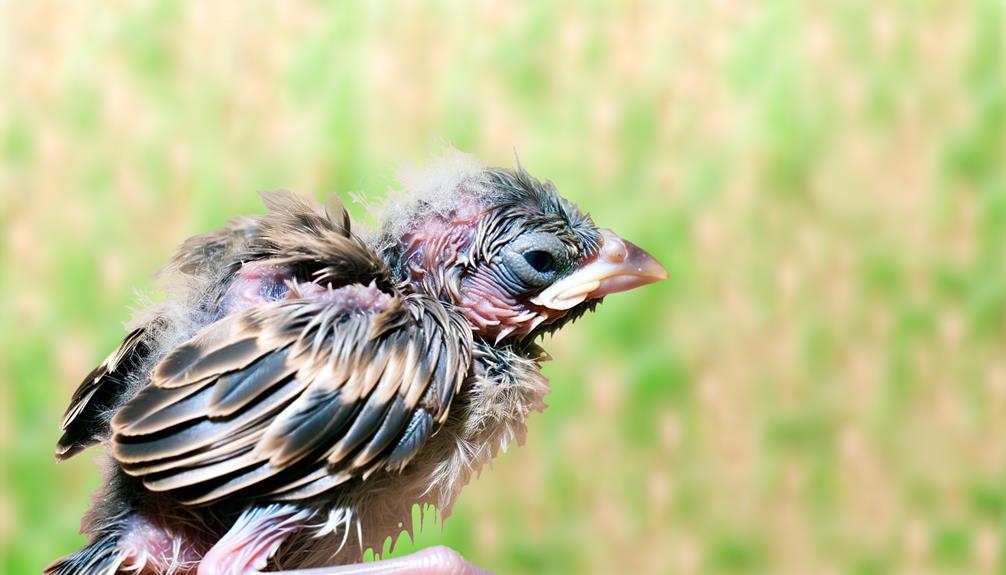
Check for any missing or patchy feathers, as these can indicate poor health.
Observe the plumage for discoloration or dullness, which might suggest nutritional deficiencies or illness.
Additionally, a ruffled or fluffed appearance could signal that the baby sparrow is struggling to maintain its body temperature.
Missing or Patchy Feathers
If a baby sparrow has missing or patchy feathers, it may indicate underlying health issues or malnutrition. You should closely observe these feather conditions to determine the severity and possible causes. Patchy feathers can result from parasitic infections, poor diet, or environmental stress. Regular monitoring and quick action can improve the bird's chances of recovery.
| Symptom | Possible Cause | Action to Take |
|---|---|---|
| Missing feathers | Parasitic infection | Consult a veterinarian |
| Patchy feathers | Malnutrition | Improve diet quality |
| Irregular growth | Stress | Reduce environmental stress |
| Feather loss | Disease | Seek medical treatment |
| Thin feathers | Poor nutrition | Provide balanced diet |
Discolored or Dull Plumage
Discolored or dull plumage in a baby sparrow often signals a deficiency in its diet or underlying health issues, requiring immediate attention to prevent further deterioration. You'll need to examine the bird closely to identify specific signs that point to a potential problem.
Here's what to look for:
- Uneven Coloring: Plumage that appears patchy or has unusual color variations can indicate malnutrition or infection.
- Loss of Shine: Healthy feathers have a natural sheen; dull feathers may signify poor health or vitamin deficiencies.
- Brittle Feathers: Feathers that break easily or lack flexibility are often a sign of inadequate nutrition.
Ruffled or Fluffed Appearance
A ruffled or fluffed appearance in a baby sparrow often indicates stress, illness, or exposure to cold temperatures, requiring a closer inspection of its overall condition.
You should first check for other signs of distress, such as labored breathing, lethargy, or discolored skin. Make sure the sparrow is kept warm, as cold can worsen its vulnerable state.
Examine the feathers for parasites or damage, as these can also cause the bird to fluff up. If the bird's behavior and condition don't improve, seek professional help from a wildlife rehabilitator.
Immediate attention to these signs can greatly impact the sparrow's chances of recovery, reflecting your dedication to serving and protecting vulnerable wildlife.
Refusal to Eat
Refusal to eat often indicates a significant health issue in baby sparrows that demands immediate attention. When you observe a baby sparrow not eating, it could be due to several reasons.
- Illness: The baby sparrow might be suffering from an underlying illness, such as an infection or parasite infestation.
- Injury: Physical trauma, like a broken wing or leg, can cause significant pain, discouraging the bird from eating.
- Environmental Stress: Factors like extreme temperatures or a noisy environment can stress the baby sparrow, leading to a refusal to eat.
Prompt intervention is vital. Consult a veterinarian specializing in avian care to diagnose and treat the underlying cause. Ensuring a calm, quiet environment can also help reduce stress and encourage eating.
Dehydration Signs
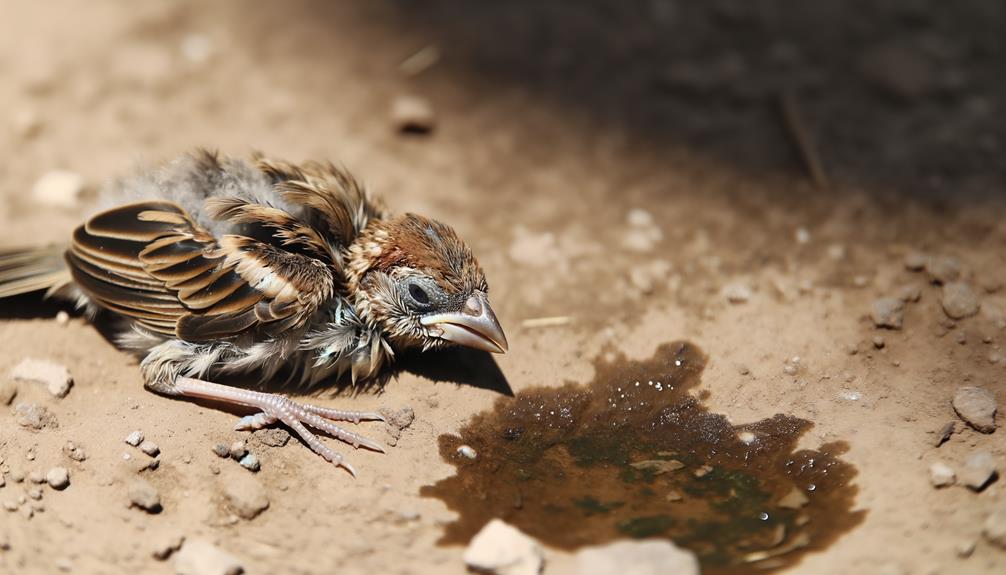
Dehydration in baby sparrows manifests through several observable signs that require immediate attention. Look for dry, sunken eyes and a lack of elasticity in the skin. If you gently pinch the skin and it doesn't quickly return to its original position, dehydration is likely.
Check the inside of the bird's mouth; a dry, sticky texture indicates insufficient hydration. Additionally, observe the droppings; hard, small feces are a clear sign of dehydration. Monitor the bird's activity level; lethargy and lack of responsiveness often accompany severe dehydration.
Promptly offer fluids like an electrolyte solution formulated for birds. Ensuring hydration can make a significant difference in the sparrow's recovery. Always keep a close watch on these symptoms to act swiftly.
Visible Injuries
Visible injuries are often the most immediate and alarming indicators that a baby sparrow is in distress. When examining the bird, you should look for specific signs that may indicate serious harm.
Here are three main types of visible injuries to check for:
- Open Wounds: Look for any cuts or lacerations on the sparrow's body, which can lead to infection if untreated.
- Broken Bones: Notice any unusual limb angles or inability to move wings and legs, which are signs of fractures.
- Bruising and Swelling: Check for areas of discoloration or swelling, particularly around the head and chest, which can indicate internal injuries.
Abnormal Droppings
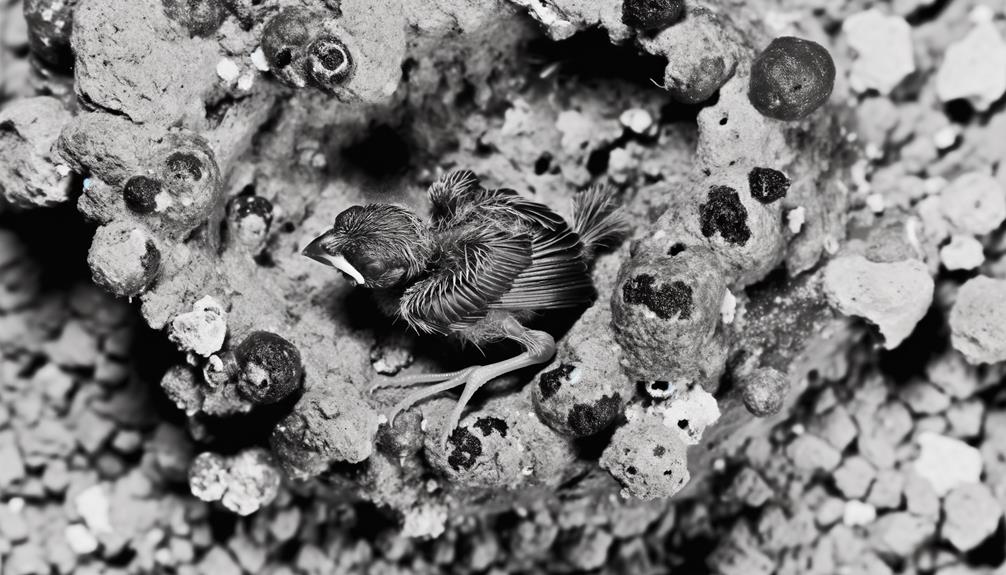
Abnormal droppings can be a critical indicator of a baby sparrow's declining health, signaling issues such as infections or dietary problems. You should examine the color, consistency, and frequency of the droppings.
Healthy droppings are typically solid with a white cap (urates). Any deviation, like watery, green, or bloody droppings, warrants immediate attention. Green droppings can indicate liver issues or bacterial infections. Watery droppings might result from stress, poor diet, or parasites. Blood in droppings is especially concerning and often points to internal injuries or severe infections.
Always use gloves when handling droppings to avoid contamination. Monitoring these signs allows early intervention, potentially saving the baby sparrow's life and ensuring it receives the care it needs.
Temperature Irregularities
Temperature irregularities in baby sparrows can be a critical sign of underlying health issues such as infections, metabolic disorders, or environmental stressors. Monitoring their body temperature is essential.
Here's what you should look for:
- Cold to the Touch: If the baby sparrow feels cold, it might be suffering from hypothermia. This condition can be fatal if not promptly addressed.
- Overheated: An excessively warm body may indicate fever due to infection. You need to cool the bird gradually and seek veterinary care.
- Fluctuating Temperature: Inconsistent temperature readings could suggest a metabolic disorder or inadequate environmental conditions. Ensure the habitat is stable and consult a professional.
Detecting temperature issues early can greatly improve the chances of recovery for the baby sparrow.
Unresponsiveness to Stimuli
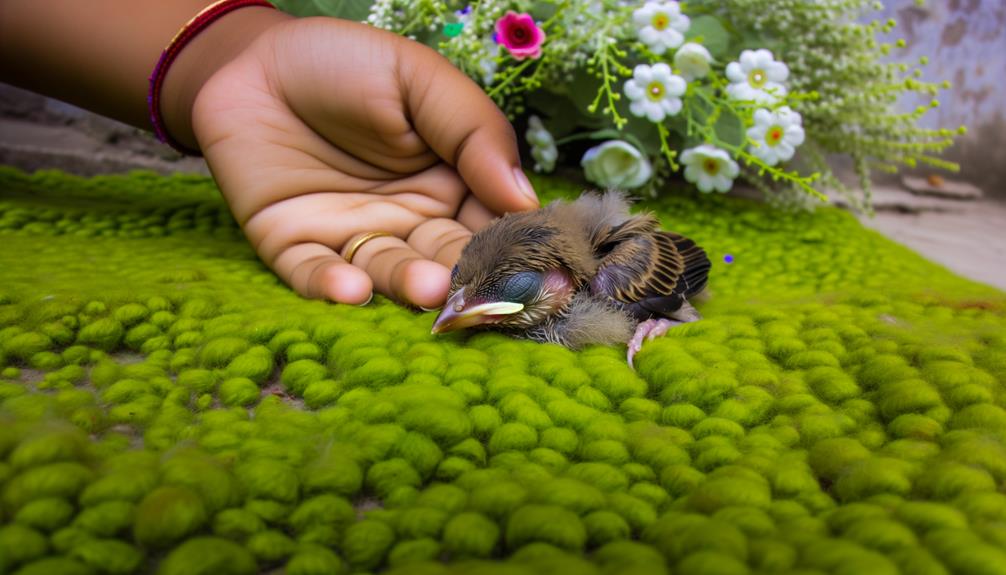
Another alarming indicator of a baby sparrow's declining health is its unresponsiveness to stimuli, which can signify severe distress or imminent death. If the sparrow doesn't react to touch, light, or sound, it's a critical sign that immediate action is necessary.
Check for reflexes by gently tapping the beak or lightly stroking the head. A healthy chick typically responds with movements or sounds. Lack of response suggests its nervous system isn't functioning properly, often due to severe illness, dehydration, or injury.
In such cases, contact a wildlife rehabilitator immediately. Quick intervention can sometimes save the bird, but unresponsiveness is a dire symptom that shouldn't be ignored. Always handle the chick gently and keep it warm to minimize stress.
Conclusion
Ironically, a baby sparrow showing signs like lethargy, labored breathing, or unusual feather conditions isn't just having a bad day. If it refuses to eat, appears dehydrated, or has visible injuries, it's not auditioning for a dramatic role.
Abnormal droppings and temperature irregularities aren't quirky habits either. So, if it's unresponsive to stimuli, don't wait for it to 'snap out of it.'
Act quickly; your timely intervention could be the difference between life and death.

